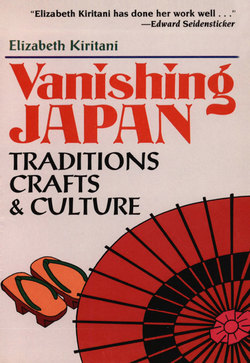Читать книгу Vanishing Japan - Elizabeth Kiritani - Страница 13
На сайте Литреса книга снята с продажи.
ОглавлениеShoe Shiners
Fuyo Torimoto is crouched under her all-purpose umbrella from 10:00 A.M. to 6:00 A.M., as she has been for the past thirty-five years, along the main street of Sapporo between Odori Park and Odori Subway Station. Her business year extends from early May until late October, when the snow appears. Other than very rainy days, she is out there every day, patiently waiting and observing the comings and goings from street level, perched on her zabuton cushion, legs folded beneath her. She has seen a lot of changes in the last four decades, she says, especially in regard to her work on the streets.
She provides her own tools and equipment, which include the all-purpose rain and sun umbrella, twenty-eight colors of shoe polish, chair, foot stand, brushes, cloths, cleaning fluids, myriad paraphernalia including a small surrounding fence, her zabuton, leg warmer (in autumn), thermos, and so on. At night she stores it all in compact form in a parking lot around the corner. The price list leaning against her polish box reads: usual 300 yen, two colors 350 yen, white shoes 500 yen, golf shoes 600 yen, suede shoes 550 yen, boots 550 yen.
We were on our way to graphic designer Kenichi Kuriyagawa's opening party at the Grand Hotel when my husband glanced down at my tan high heels and scolded me for not taking better care of them. "People in Japan polish their shoes," he grumbled, just as we were passing Mrs. Torimoto's stall. Seizing the moment, I plunked myself down on the fold-out chair and gave her what must have been an unusual challenge: shoes that hadn't been polished in two whole years.
Ten minutes and 300 yen later the shoes had been transformed almost as if by magic and I had been entertained thoroughly by this vibrant, industrious seventy-five-year-old woman. It was no surprise to learn that she has a number of "steady customers"— mostly businessmen—who stop regularly to have a chat and polish three or four times a month, year after year. "Even though business is waning, it's a job that can really educate you in many ways," she said. "And it certainly is a whole lot better than staying home and watching TV."
Mrs. Torimoto has been a widow since the war and has had to struggle to bring up her daughter. Now she has two grandsons of whom she is proud, and she spends the money she makes from her shoe polishing on presents and things that she likes to buy for these kids.
In 1952 there were about 180 shoe shiners lining the main street from Sapporo Station to Susukino; today there are only 23. "One of the reasons, of course, is that shoe shining isn't a very appealing job for young people," she says. "They'd rather be doing something more active than sitting around and waiting for a pair of dirty shoes to show up. But this isn't by any means the whole reason," she adds.
"Take a look at the shoes people are wearing today," she shakes her head from side to side, "lust look at them! The high heels are all made out of vinyl. Cheap! You can't polish vinyl. People are no longer buying fine leather shoes. Some men still do, of course, but they are getting to be fewer and fewer. And you can't polish sneakers, either," she added.
These days she shines an average of seven or eight pairs of shoes a day: about 2,400 yen's worth. During the day when she isn't busy shining shoes and chatting to her customers, a fellow shiner often stops by to share some news or part of her lunch. Mrs. Torimoto is fortunate to have a place to live and enough money to live on. In her case, the business of shoe shining is more than just a paying job. It is a connection to the everyday world, a connection to other people, her polishes reflecting a life dedicated to hard work and endeavor.
